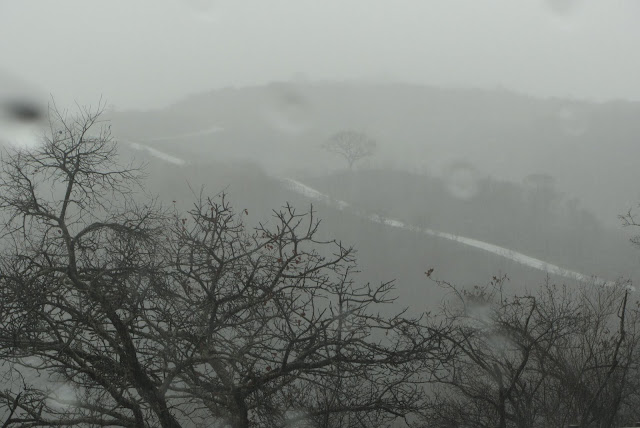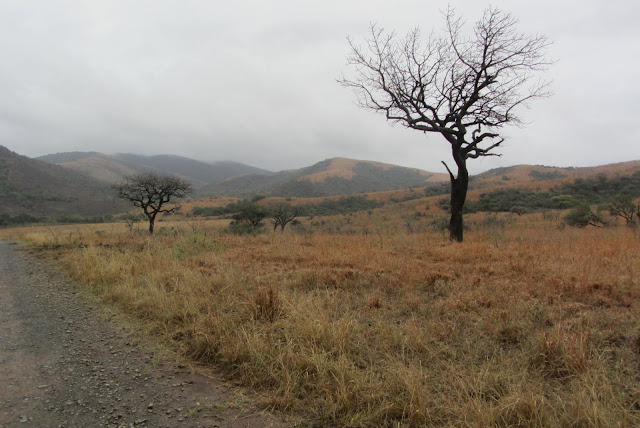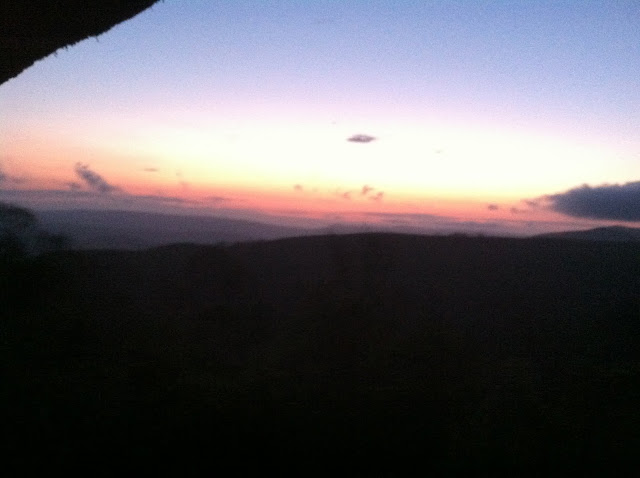Day 10,11,12 we spent in the Hluhluwe-iMfoloze
park. The Hluhluwe-iMfolozi is the oldest park in South Africa. It was
established in 1820’s for the sole hunting pleasure of King Shaka of the Zulu
nation. It is now part of the national park system. A interesting fact is that
the park must hire 60% female, 25% youth, and 2% handicapped. Only one person
from a household can be hired to spread the income. Preference is given to those
affected by HIV/AIDS.
To say Day one was wet was a understatement. We ventured
out and again I drove for 5 hours at 10 MPH while the Princess looked for
wildlife. The animals, like I wanted, were home hiding from the rain. We did
manage to see some animals including a rhino, but I missed the shot, and some
giraffe. We were on the unpaved roads and by the end of the day we were
slipping and sliding in the mud.
how do the animals no not to come beyond this sign and eat me fat ass
yep, i am safe now.
vicki drawning out of the lines again
lunch in the park
one of relatives having lunch
hope we can get our of here
we came across a big cat on the side of the road
griaff1
Day two was more of the same but by now the ground was
water logged and the rivers were overflowing the bridges. All of South Africa is
under this unsuspected weather system and floods are reported throughout the
whole country. Our plan had to been to go to the south end of the park, but the
river was over the bridge so we were trapped. To drive out of the park and
around was a three hour round trip and the gate closes at six, so that would not
leave much time to scoot game. Again we did come across various animals and
todays animal was the zebra. We had dinner at the lodge. It was a BBQ.
well, we are not going that way today
did i mention it is raining
two female park rangers out patrolling in the fine weather. when we drove up their hoods were down and had trash bag hats, but pulled up the hoods for the photo
nope, not going that way either
large areas of the park are burned off every year in a controlled burn
We met Dr. George Hughes the former CEO of the South African Park system and had a great chat. One of the places we were trying to get to today was the game capture center in the other park. He said they started that while he was CEO and they sold hundreds of animals a year and still do. They recently had sold a water buffalo for 26,000,000 rand or over $3,000,000, mainly because of it’s horns. It will be used for breed stock on the private reserves and eventually shot as a game trophy. Hundreds of thousands will be paid by some one to kill it. The capture center sales animals all over the world and a lot to Texas game ranches. In the past ranchers could buy just one animal. The park would sell it for say $100,000, and then the buyers would turn around and sell the opportunity to shot it for $150,000. The process has been changed, so if someone wants to buy, say a rhino, they must buy a male and four females. After offspring are produced, the game ranch can then sell the rights to shot the purchased animals. The hope is to continue the blood line as opposed to shooting them just for game trophy. Some people call this “sport”. I agree with the golfer Nick Faldo who said, “It is not a sport unless both sides know it is a sport.”
me and dr. hughes
Day three dawned with a sun and clearing skies. Who would
have guessed that the day would contain eight and a half hours of driving at 10
mph. The Princess, like King Shaka was chauffeured all over the park. We were
out and so were all the animals. First was the animal capture center. Dr.
Hughes name was on the big buck sponsor list plaque but they said, “No Dr.
Hughes, no see the animals”. So off we went to find them on our own. We were
very successful. The animals were as happy as us to see the sun and they were
out in force, rhinos, elephants, giraffes, zebras, kudos, impala, baboons,
monkeys, and more. Not to mention all the birds.
the local gas station
The Masked Weaver
The Ploceus wavers are surely the most characteristic of the African
bird genera, and the masked weaver is probably the commonest of species in South
Africa. The dexterous male builds intricate, ball shaped nests at the end of a
thin hanging branch, which is stripped of leaves as a protection against snakes.
Once completed, the nest is inspected by the female, who deconstructs it
ruthlessly if deems it unsatisfactory.
Sound familiar guys
There are some slideshows and video that the internet is not letting me post at the moment. I will work on that and see if I can post them later.
There are some slideshows and video that the internet is not letting me post at the moment. I will work on that and see if I can post them later.









































